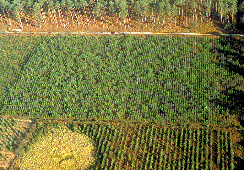Using Forest Reproductive Material
The success of a forest plantation depends on the responsible use of FRM, among other factors.
For a successful forest plantation, FRM must, among other factors:
- Be adapted to the plantation area (soil in particular)
- Be of good genetic and phenotypic quality
- Cover sufficient genetic diversity to ensure resistance to climatic and sanitary hazards.
Forest research programmes have highlighted important differences in performance between tree species of different provenance. For tree species used more for reforestation purposes, research programmes have been used to develop improved forest varieties with superior performances (for a given pedoclimatic range) compared to forest genetic resources of identified and selected categories.
In this context, Irstea has come up with recommendations for using FRM, in an aim to guide tree planters in choosing material which is adapted to their region and meets their objectives. Along with a technical guide called “Réussir la plantation forestière“, recommendations are set out in species sheets which remind the reader of general characteristics and available basic materials, and indicate the FRM to opt for depending on the region of use.
In order to adapt French forests to climate change, and in the framework of the National Plan for Adaptation to Climate Change 2011-2015, the Ministry of Agriculture has commissioned Irstea to run an ongoing review programme of these recommendations, in view of this objective. The programme aims to take climatic risks into account for the next forestry cycles, for different species and areas of use. This will avoid creating or renewing stands which will not last, and help move towards using FRM that will allow for better adaptation in a changing environmental context.





